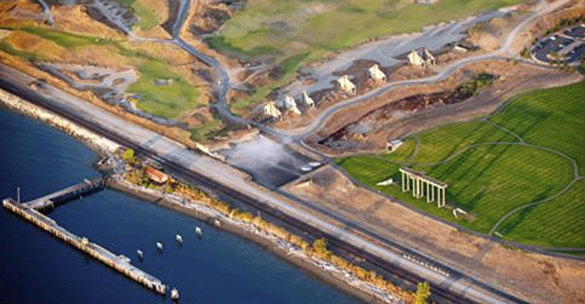The Washington State Department of Natural Resources this week will begin to remove approximately 32 derelict creosote-treated pilings located in the tidelands at Sunnyside Beach Park in Steilacoom, as well as two dilapidated docks along the Chambers Creek Regional Park’s shoreline in University Place in an effort to restore intertidal and near-shore habitats and improve overall water quality.
“The shallows along these beaches offer significant forage fish spawning habitat,” said Washington State Department of Natural Resources Aquatic Resources Division Manager Kristin Swenddal. “Creosote has been found to negatively affect the survival rate of herring eggs, so we and our partners are working to remove as much creosote from Puget Sound ecosystems as possible. In addition, the old docks at this site are crumbling and pose a public safety risk.”
Creosote is a heavy, oily liquid made from coal tar or wood tar and used as a wood preservative. According to Swenddal and other Washington State Department of Natural Resources officials, creosote-treated materials leach chemicals into beach and marine sediments, creating toxic conditions for organisms living in and using these areas.
The work at Sunnyside Beach Park will begin on Thurs., Sept. 18, and is expected to be completed by the end of September. The beach will remain open during the project, although beach access will be restricted in the immediate area surrounding the work.
After the Sunnyside Beach Park work is complete, the Washington State Department of Natural Resources will remove two creosote-treated docks—including pilings and associated concrete structures—from the north and south dock areas located along the Chambers Creek Regional Park’s 2.5-mile-long beach. The two docks have 12,150-square-feet of decaying decking and close to 800 creosote and concrete pilings. Beach access will be restricted in the immediate area surrounding the work.
“We are excited to have these areas safe for the public and aquatic life,” said Pierce County Executive Pat McCarthy. “Thanks to the hard work by Pierce County’s legislative delegation in Olympia, the state set aside funding to nurture and protect our amazing shoreline.”
The south dock will be removed once the purple martin nesting season is over, which is typically in September. If purple martins are still present when the Steilacoom portion of the project is complete, the contractor will begin demolition of overwater structures at the north dock. On Weds., Oct. 1, the contractor will move to the south dock then up the shoreline to the north dock to complete the removal process there. The work is expected to be finished by the end of this year. This timeline aims to minimize the impact on existing marine and avian habitats. The docks and pilings are located primarily on state-owned aquatic lands.
The two docks and associated pilings have degraded to the point that they have become a significant hazard to the environment as well as recreational and marine traffic around South Puget Sound, according to Washington State Department of Natural Resources officials. The unused structures block the natural movement of sediment and provide unwanted shading along the critical nearshore habitat. Removal of creosote helps restore intertidal and near shore habitats and improves overall water quality.
The estimated cost of Pierce County’s portion of the project is $2.5 million, which is funded by an appropriation in the Washington Legislature’s 2013-15 capital budget, to be administered through the Washington State Department of Ecology. The Washington State Department of Natural Resources will use approximately $1.7 million for the removal of in-water pilings and docks. Pierce County will provide the remaining $788,800 for onshore cleanup work. The contractor for the project is Orion Marine Contractors, Inc.
The Washington State Department of Natural Resources is leading efforts throughout Puget Sound to remove creosote-treated structures, pilings, and debris from Washington’s marine and estuarine waters.
Last year, Pierce County removed approximately 200 derelict creosote pilings from Chambers Creek Regional Park after receiving $160,000 in grant funding provided by the U.S. Environmental Protection Agency’s National Estuary Program and administered by the Washington State Department of Ecology’s Water Quality Program.





